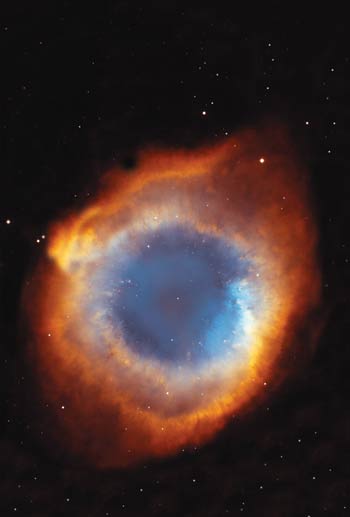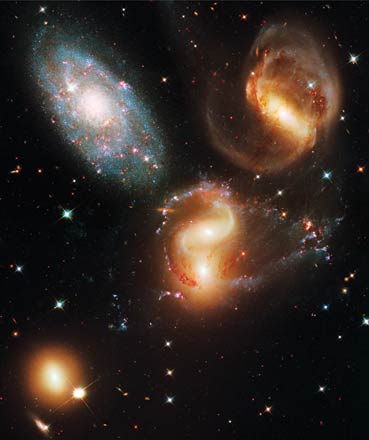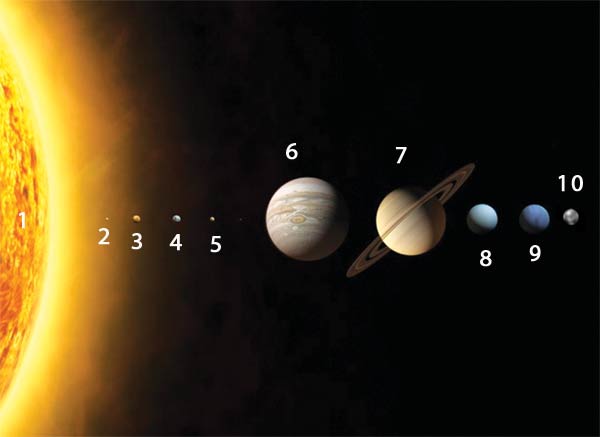…Something else has to be behind things, somehow guiding them. And that, one might say, is a kind of mathematical proof of divinity. Guy Marchie, American Science Writer 44
During the night of July 4th in 1054, Chinese astronomers witnessed an extraordinary event: a very bright star that suddenly appeared near the constellation Taurus. It was so bright that it could easily be seen even in daytime. At night it was brighter than the Moon.
 |
What Chinese astronomers observed was one of the most interesting and catastrophic astronomic phenomena in our universe. It was a supernova.
A supernova is a star that is shattered by an explosion. A huge star destroys itself in an immense blast and the material of its core is scattered in every direction. The light produced during this event is a thousand times brighter than normal.
Scientists today think that supernovas play a key role in the formation of the universe. These explosions are what cause different elements to be carried to different parts of the universe. It is supposed that the material ejected by these explosions subsequently combines to form a new galaxy or a star somewhere else in the universe. According to this hypothesis, our solar system, the Sun and its planets including Earth, are the products of some incredibly ancient supernova.
Although supernovas may seem to be ordinary explosions, they in fact are minutely structured in their details. In Nature's Destiny Michael Denton writes:
The distances between supernovae and indeed between all stars is critical for other reasons. If the distance between stars in our galaxy was much less, planetary orbits would be destabilized. If it was much more, then the debris thrown out by a supernova would be so diffusely distributed that planetary systems like our own would in all probability never form. If the cosmos is to be a home for life, then the flickering of the supernovea must occur at a very precise rate and the average distance between them, and indeed between all stars, must be very close to the actual observed figure.45
The ratio of supernovas and stars' distances are just two more of the fine-tuned details of this miraculous universe. Examining deeper the universe the arrangement we see is beautiful both in the organization and order.
 |
| Today's science proves the reality of the Creation of the universe by Allah, contrary to what outdated materialist philosophy maintains. Newsweek made "Science Finds God" the cover story of its July 27th 1998 issue. |
Let's recap a few points that we made earlier. The universe following the Big Bang was a nebula of just hydrogen and helium. Heavier elements were produced later by means of specially created nuclear reactions. Yet the existence of heavier elements is not a sufficient reason for the universe to become a suitable place for life. A much more important issue is how the universe was formed and ordered.
We shall start by asking how big the universe is.
The planet Earth is a part of the solar system. In this system there are nine major planets with fifty-four satellites, and an uncounted number of asteroids all revolving around a single star called "Sun", a middle-sized star compared with others in the universe. Earth is the third planet from the Sun.
Let us first try to understand the size of this system. The diameter of the Sun is 103 times that of the Earth. To visualize this, the planet Earth has diameter of 12,200 kms. If we scaled that down to the dimensions of a glass bead, the Sun would be about the size of soccer ball. But the interesting thing is the distance between the two. Keeping to the same scale, the two balls should be 280 meters apart. Some of the objects representing the outer planets would have to be set several kilometers away.
Big though this might seem, the solar system is a quite miniscule in size compared with the Milky Way, the galaxy in which it is located. There are over 250 billion stars in the Milky Way–some similar to the Sun, others bigger, others smaller. The star nearest to the Sun is Alpha Centauri. If we wanted to add Alpha Centauri in our model system, it would have to be located 78,000 kilometers away.
 |
| We have adorned the nearest heaven with an adornment, the stars. |
That's too big for almost anyone to grasp, so let's reduce the scale. We'll assume the Earth to be as big as a dust-particle. That would make the Sun as big as a hazelnut about three meters from the Earth. On this scale, Alpha Centauri would have to be located 640 kilometers from the Sun.
The Milky Way consists of about 250 billion stars with similarly mind-boggling distances between them. The Sun is located closer to the edge of this spiral-shaped galaxy than it is to the center.
Even the Milky Way is dwarfed by the vast size of the whole universe. It is just one of many galaxies–nearly 300 billion of them according to recent calculations. And the distances between galaxies are millions of times greater than that between the Sun and Alpha Centauri.
George Greenstein, in The Symbiotic Universe, comments on this enormous vastness:
Had the stars been somewhat closer, astrophysics would not have been so very different. The fundamental physical processes occurring within stars, nebulas, and the like would have proceeded unchanged. The appearance of our galaxy as seen from some far-distant vantage point would have been the same. About the only difference would have been the view of the night time sky from the grass on which I lie, which would have been yet richer with stars. And oh, yes–one more small change: There would have been no me to do the viewing…All that waster space! On the other hand, in this very waste lies our safety.46
Greenstein also explains the reason for this. In his view, the huge distances in space makes it possible for certain physical variables to be arranged so as to be exactly suitable for human life. He also notes the importance of this huge space in allowing Earth to exist while minimizing the risk of collision with other stars.
In short, the distribution of celestial bodies in space is exactly what it must be for human life to exist on our planet. These huge spaces are the outcome of a special Creation and not a result of coincidence.
 |
| An abandoned car deteriorates and falls apart. Everything in the universe is subject to entropy: the law says that, left to itself, everything becomes less stable and less organized with the passage of time. |
In order to understand the concept of order in the universe, we need first to talk about the Second Law of Thermodynamics, one of the fundamental universal physical laws.
This law states that, left to themselves, organized systems will become unstable and less organized as time advances. This law is also called the Law of Entropy. In physics, entropy is the amount of disorder in a system. The transition of a system from a stable condition into an unstable condition is the same as an increase in its entropy. The instability is directly related to the entropy of that system.
This is commonplace knowledge, many examples of which we may observe in our daily lives. If you abandon a car in some exposed place for a year or even a couple of months, you certainly wouldn't expect it be in just as good condition as you left it when you return. You'll probably notice flat tires, broken windows, corroded parts in the engine and body, etc. Similarly if you neglect to straighten up your house for a few days and you‘ll immediately see it getting dustier and more disorganized as time goes by. This is a kind of entropy; however you can undo it by cleaning and picking things up and by taking out the trash.
The Second Law of Thermodynamics is widely accepted as valid and binding. Einstein, the most important scientist of our century, said that this law was the "first law of all sciences". The American scientist Jeremy Rifkin comments in Entropy: A New World View:
The Entropy Law will preside as the ruling paradigm over the next period of history. Albert Einstein said that it is the premier law of all science: Sir Arthur Eddington referred to it as the supreme metaphysical law of the entire universe.47
 |
| Every galaxy in the universe is proof of the organized structure that everywhere exists. These magnificent systems, with an average of 300 billion stars each, display an evident balance and harmony. |
It is important to note that the Law of Entropy by itself renders many of the claims of materialism invalid right from the start. For if there is a definite order in the universe, the law holds that, in the course of time, this situation will be undone by the universe itself. There are two conclusions to be reached from this observation:
1) Left to itself, the universe cannot exist for eternity. The second law says that without external intervention of some sort, entropy will eventually be maximized throughout the universe causing it to assume a completely homogenous state.
2) The claim that the order we observe is not the result of external intervention is also invalid. Immediately after the Big Bang, the universe was in precisely such a completely disorganized state as would exist if entropy had been maximized. But that has changed as we can plainly see by looking around. That change took place in violation of one of nature's fundamental laws–the Law of Entropy. There is simply no way to account for this change except to posit some sort of supernatural Creation.
An example will perhaps make the second point clearer. Imagine the universe to be a huge cave full of a jumble of water, rocks, and dirt. We leave the cave alone for several billion years and then come back and take a look at it. Upon our return we notice that some of the rocks have gotten smaller, some have disappeared, the level of dirt is higher, there's more mud, and so on. Things are more disordered, which is normal–just as we might expect. If, billions of years later, you find rocks delicately carved into statues, you would definitely decide that this order cannot be explained away by laws of nature. The only rational explanation is that "a conscious mind" caused these things to be.
 |
| NOBEL PRIZE WINNER PHYSICIST MAX PLANCK: |
So the order of this universe is the most overwhelming proof of the existence of a superior consciousness. The Nobel prize winner German physicist Max Planck explains the order in the universe:
At all events, we should say, in summing up, that, according to everything taught by the exact sciences about the immense realm of nature in which our tiny planet plays an insignificant role, a certain order prevails–one independent of the human mind. Yet, in so far as we are able to ascertain through our senses, this order can be formulated in terms of purposeful activity. There is evidence of an intelligent order of the universe.48
Paul Davies explains the triumph of this marvelous equilibrium and harmony over materialism thus:
Evrende nereye bakarsak bakalım, en uzaktaki galaksilerden atomun derinliklerine kadar, bir düzenle karşılaşırız... Bu düzenli, özel evrenin merkezinde "bilgi" kavramı yatmaktadır. Yüksek derecede özelleşmiş olan ve organize edilmiş bir düzenleme sergileyen bir sistem, tarif edilebilmek için çok yoğun bir bilgi gerektirir. Ya da bir başka deyişle bu sistem yoğun bir "bilgi" içermektedir...
Everywhere we look in the Universe, from the far flung galaxies to the deepest recesses of the atom, we encounter order... Central to the idea of a very special, orderly Universe is the concept of information. A highly structured system, displaying a great deal of organised activity, needs a lot of information to describe it. Alternatively, we may say that it contains much information.
We are therefore presented with a curious question. If information and order always has a natural tendency to disappear, where did all the information that makes the world such a special place come from originally? The Universe is like a clock slowly running down. How did it get wound up in the first place?49
 |
| ALBERT EINSTEIN: |
Einstein refers to this order as an unexpected event, and also says that it should be regarded as a miracle:
Well, a priori [reasoning from cause to effect] one should expect that the world would be rendered lawful [obedient to law and order] only to the extent that we [human beings] intervene with our ordering intelligence... [But instead we find] in the objective world a high degree of order that we were a priori in no way authorized to expect. This is the ‘miracle' that is strengthened more and more with the development of our knowledge.50
In short, the order in the universe demands deep and extensive understanding and knowledge. It is organized and preserved by Allah.
Allah reveals how the heavens and earth are preserved by His supreme power in the Qur'an:
Allah keeps a firm hold on the heavens and earth, preventing them from vanishing away. And if they vanished no one could then keep hold of them. Certainly He is Most Forbearing, Ever-Forgiving. (Surah Fatir: 41)
The divine order in this universe reveals the weakness of the materialistic belief of a universe that is a mass of ungoverned matter. This is revealed in another verse:
If the truth were to follow their whims and desires, the heavens and the earth and everyone in them would have been brought to ruin… (Surat al-Muminun: 71)
 |
| Isaac Newton, one of the pioneers and founders of modern physics and astronomy, saw in the structure of the universe magnificent evidence of divine Creation. |
The solar system is one of the most wonderful examples of this beautiful harmony to be witnessed. There are nine planets with fifty-four known satellites and an unknown number of smaller bodies. The major planets counting outward from the Sun are Mercury, Venus, Earth, Mars, Jupiter, Saturn, Uranus, Neptune, and Pluto. Earth is the only one on which life is known to exist. It is surely the only one on which human beings can live and survive unaided as a means of abundant land and water and to a breathable atmosphere.
In the structure of the solar system, we encounter another beautiful example of equilibrium: the balance between a planet's centrifugal force countered by the gravitational attraction of its primary. (In astronomy, a primary is something that another body revolves about. The Earth's primary is the Sun; the Moon's primary is the Earth.) Without this balance, everything in the solar system would fly off into the chilling depths of outer space. The balance between these two forces results in paths (orbits) that the planets and other bodies follow around their primaries. If a body moved at too slow a speed, it would plunge into the primary; if it moved at too fast a speed, the primary would be unable to hold onto it, and it would fly off into space. Instead, every body moves at just the right speed to keep it in orbit. Moreover, this equilibrium has to be different for each body because the distance of planets to the Sun differs. So do their masses. Therefore, they have to have different orbital speeds not to plunge into the Sun or not to fly off into space.
THE SOLAR SYSTEM | |||
 | |||
| 1. Sun, | 4. Earth, | 7. Saturn, | 10. Pluto |
| It is not for the Sun to catch up the Moon nor for the night to outstrip the day. Each (just) swims along in (its own) orbit. | |||
Materialist astronomy falsely claims that the origin and survival of the solar system can be explained by coincidence. Over the last three centuries, many of its adherents have speculated without any evidence on how this marvelous order should have come to pass and they have failed to get anywhere. To a materialist, the equilibrium and order of the solar system are inexplicable mysteries.
Astronomers like Kepler and Galileo, among the first to discover this superlative equilibrium, acknowledged it as a sign of Creation of the whole universe. Isaac Newton, recognized as one of the most important scientific minds of all times, once wrote:
This most elegant system of suns, planets, and comets could arise from the purpose and sovereignty of an intelligent and mighty being…He rules them all, not as a soul but as a sovereign lord of all things, and because of His sovereignty He is commonly called "Lord God Almighty."51
Besides this wonderful equilibrium, the place of Earth in the solar system and in the universe is also another piece of evidence of a perfect act of Creation on Allah's part.
The latest astronomical findings have shown the importance of the other planets' existence for Earth. Jupiter's size and position turn for example out to be critical. Astrophysical calculations show that, as the biggest planet in the system, Jupiter supplies stability to the orbits of Earth and all the other planets. Jupiter's protective role over the Earth is explained in an article "How special Jupiter is" by George Wetherill:
Without a large planet positioned precisely where Jupiter is, the earth would have been struck a thousand times more frequently in the past by comets and meteors and other interplanetary debris. If it were not for Jupiter, we wouldn't be around to study the origin of the solar system.52
To put it briefly, the structure of the solar system was specially created for mankind to live.
Let us also consider the place of solar system in the universe. Our solar system is located in one of the huge spiral arms of the Milky Way, closer to the edge than to the center. What advantage could there be in that? In Nature's Destiny, Michael Denton explains:
What is so striking is that the cosmos appears to be not just supremely fit for our own being and for our biological adaptations, but also for our understanding... Because of the position of our solar system on the edge of the galactic rim, we can gaze farther into the night to distant galaxies and gain knowledge of the overall structure of the cosmos. Were we positioned in the center of a galaxy, we would never look on the beauty of a spiral galaxy nor would we have any idea of the structure of our universe.53
In other words, even Earth's location in the galaxy is evidence that it was intended for mankind to live on, no less than are all the other physics laws of the universe.
It is the plain truth that the universe is created and arranged by Allah.
The reason that some people cannot understand this point is their own prejudice. But any objective mind without prejudice will easily understand that the universe is created and organized for mankind to live in, just as is revealed:
We did not create heaven and earth and everything in between them to no purpose. That is the opinion of those who are unbelievers… (Surah Sad: 27)
This deep understanding is revealed in yet another verse of the Qur'an:
In the Creation of the heavens and the earth, and the alternation of night and day, there are signs for people with intelligence: those who remember Allah, standing, sitting and lying on their sides, and reflect on the Creation of the heavens and the earth: ‘Our Lord, You have not created this for nothing. Glory to You!" (Surah Al 'Imran: 190-191)
44. Guy Murchie, The Seven Mysteries of Life, Boston: The Houghton Mifflin Company, 1978, p. 598 ![]()
45. Michael Denton, Nature's Destiny, p. 11 ![]()
46. George Greenstein, The Symbiotic Universe, p. 21 ![]()
47. Jeremy Rifkin, Entropy: A New World View, New York, Viking Press, 1980, p. 6 ![]()
48. Max Planck, May 1937 address, quoted in A. Barth, The Creation (1968), p. 144 ![]()
49. Paul Davies, The Accidental Universe, (1982) Cambridge: Cambridge University Press. Preface ![]()
50. Albert Einstein, Lettres á Maurice Solovine, 1956, p. 114-115 ![]()
51. Michael A. Corey, God and the New Cosmology: The Anthropic Design Argument, Maryland: Rowman & Littlefield Publishers, Inc., 1993, p. 259 ![]()
52. G. W. Wetherill, "How Special is Jupiter?", Nature, vol. 373, 1995, p. 470 ![]()